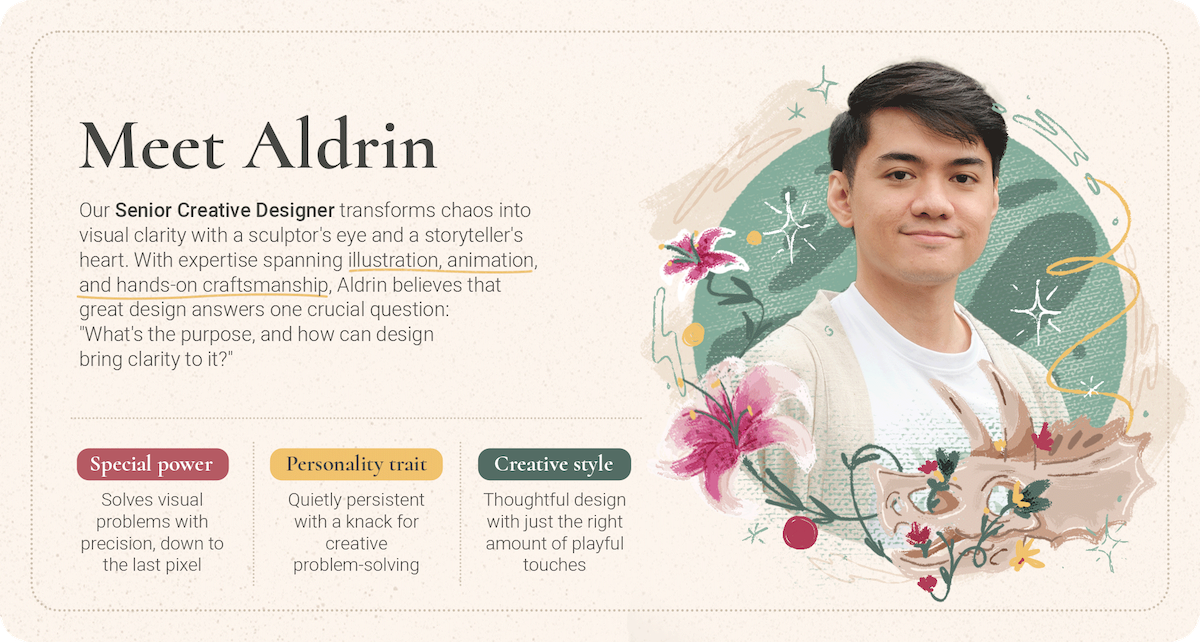
Delivering client requirements can feel like walking a tightrope. Whatever side of the marketing divide you sit on, you have to balance a set of often conflicting demands, make sense of mixed messages, and contend with your personal biases.
Most of the time we succeed without issues, but some days feel especially shaky — like there’s no safety net below.
A few years back, we’d been briefed by a new client — a digital bank that provided cutting-edge digital banking services to MSMEs (micro, small, and medium enterprises). Marketing agencies live to serve these types of businesses: trendsetters catering to an underserved and often misunderstood demographic.
We went into the project confident about the outcomes… perhaps too confident, as the mixed message we initially sent almost cost us the contract. But setting aside our ego and practising active listening helped us get right back on track!
(Plus, reflecting on our mistakes led us to develop frameworks for pain-point messaging — we’re sharing them below.)
Working with an early adopter
Southeast Asia’s MSMEs face many financial barriers — strict lending criteria from banks, businesses’ lack of collateral, and insufficient credit history among them. Digital banks believe they can disrupt this status quo and make finance more inclusive.
The client was an early adopter of digital banking services — instead of offering a giant portfolio of financial products, they focused on a few services relevant to MSMEs’ needs. A loan product, a savings product with multiple currencies, an FX service and an app to manage them all.
Exciting mission, exciting message. Should be a shoo-in for great content, right?
Talking to banks vs. talking to bank customers
The first few drafts missed the mark. We’d put on our “financial institution writing” hat and figured what won our other banking clients over would also work for this new client.
We’d fallen into a “seen many, seen all”trap, assuming that all banking copy had to emulate a certain tone and content approach — professional, sober, and reassuring to C-suite executives. Our content had too many macro references (Quotes from ministerial speeches! World Bank papers!).
Our other clients (and their legal teams) expected us to write about money from a somewhat disinterested point of view. They expected us to support assertions with stats from recent studies; we felt obliged to make a sober and analytical case for the banking service, befitting readers who crunched numbers for a living.
But that was the last thing our client wanted.
“Our audience doesn’t speak like this”
The client was aligned with their readers’ expectations: content that connected directly to MSMEs, by addressing their needs first, in plain language. The brief had already made it clear: “Don’t make us sound like a bank — make us sound like a trusted partner that understands what a typical entrepreneur wants, and can advise on what they need.”
The client understood that MSME entrepreneurs aren’t financial experts, well-versed in complex banking jargon. Instead, they head small, family-run operations of three to ten people; they’re located in HDBs, not in gleaming modern offices; and they’re more concerned with practical day-to-day decisions that keep their businesses afloat.
Audiences want to see themselves in the content we create. Our client’s target readers were looking for content that had a direct bearing on their day-to-day financial struggles and immediate needs. To support cash flow disruptions from late-paying customers, they wanted to learn about loans with manageable interest rates. To minimise FX fees that came with transacting with foreign clients, they needed to hear about multi-currency accounts that could lower those costs.
The sober, analytical content failed to meet the brief that the client had set. The same thinking routines that stood us well for other financial clients failed our MSME readers — the data dump we were writing just created clutter that our MSME readers quickly tuned out.
“Our audience doesn’t speak like this,” relayed a frustrated client in a critical postmortem meeting. “What’s the point of bringing up Singapore’s unbanked population? Why do you need to mention the Ministry of Finance’s position on debt? You guys sound like a bank executive trying to make friends with a shopkeeper, but failing.”
Tensions rose: the client expressed dissatisfaction, hinting at looking elsewhere for another agency who could convey the tone better. The lack of alignment with brand and audience was putting our contract in danger, unless we could rethink our content to better reflect the values, challenges, and language of our MSME target audience.
A deeper dive into our readers’ world
Back at square one, we considered how to change the way we communicated. The brief had defined the target audience but didn’t give much detail on their motivations.
Our first mistake lay in taking the brief at face value, filling in the blanks with our previous experience creating for financial institutions (which obviously no longer applied). So we did even deeper research on MSMEs, and revised our understanding of this audience’s needs.
- Pain points and aspirations: They face challenges like cash flow management and balancing family and business, but also aspire to grow and leave a legacy.
- Values and priorities: Family businesses like our readers’ don’t hold corporate metrics in high regard, instead prioritising relationships, trust, and community impact.
The more we explored our target audience, the more we realised that another perspective shift was needed. While we were technically marketing to a business audience, we were in reality marketing to individuals — business owners who wield supreme executive decisions in their own enterprises, but from a more personal level that suited a B2C approach more than a B2B one.
From a marketing standpoint, we knew that every individual experiences pain points on different levels: practical, professional, and personal. (We adapted this concept from Sandler sales methodology’s Sandler Pain Funnel.)

Like kueh lapis, customer pain comes in layers. The 3PI framework classifies pain points into Practical Issues, Professional Impact, and Personal Implications. It’s adapted from the Sandler sales methodology’s pain funnel.
Based on this new understanding of our reader, we pivoted away from the old approach to re-centre our content around the average entrepreneur’s priorities:
- Personal relationships over business jargon: Entrepreneurs value empathy and familiarity over corporate language;
- Practicality over polish: Managers of family businesses respond better to clear, no-nonsense communication that speaks to their day-to-day challenges; and
- Storytelling over data: MSME owners relate to stories about other small businesses like them, not generic financial advice.
Upending the usual writing approach, we decided to infuse the content with a warmer, more conversational tone, using everyday language. We replaced jargon with direct, actionable language that reflected the way MSME owners actually talk.
Winning the client back
Returning to the client with the first draft revision that incorporated these insights, the client immediately saw the difference. So did our MSME readers: engagement rates increased, and readers responded positively on social media.
Not only were we able to retain our clients’ patronage, we also deepened the relationship — consolidating our position as a trusted partner for future campaigns. We’ve since created more content for the client, with the revised perspective always at the forefront.
We won’t soon forget the lessons we learned from this near-miss, key among them:
- Admit mistakes and pivot quickly. This can save client relationships. We often establish best practices based on lessons learned from our mistakes, and this improves the work we do for our clients.
- Look beyond the brand to the audience it serves. While it’s important to highlight the brand’s value proposition, it’s just as important to show how the brand or service meets the audience’s specific pains. You can then find the ideal message positioning where these two intersect.

Use the Value Proposition-Pain Point Merger framework to guide your message positioning
- Know who you’re really talking to — and don’t confuse your company’s (or client’s) priorities with your audience’s. For us, targeting MSMEs meant ditching a traditional B2B mindset and taking a business-to-individual approach, zeroing in on the business owner. With MSMEs, the personal is the professional. Unlike selling to big corporates, we had to dig deeper — into values, language, and pain points that hit closer to home. That meant shifting away from a dry, functional pitch and getting personal, practical, and emotionally relevant.
In the end, the project was a great exercise in going back to basics: finding the balance between audience pains and the product proposition that couldn’t simply be answered by our past experience with banking clients. By applying the right frameworks to our content marketing strategy, we provided the value that our client sought — and managed to win them back, all over again.
—
200+ industry-leading tech companies in Southeast Asia are happy clients of With Content. Join them and start delivering valuable content to your potential customers today.



